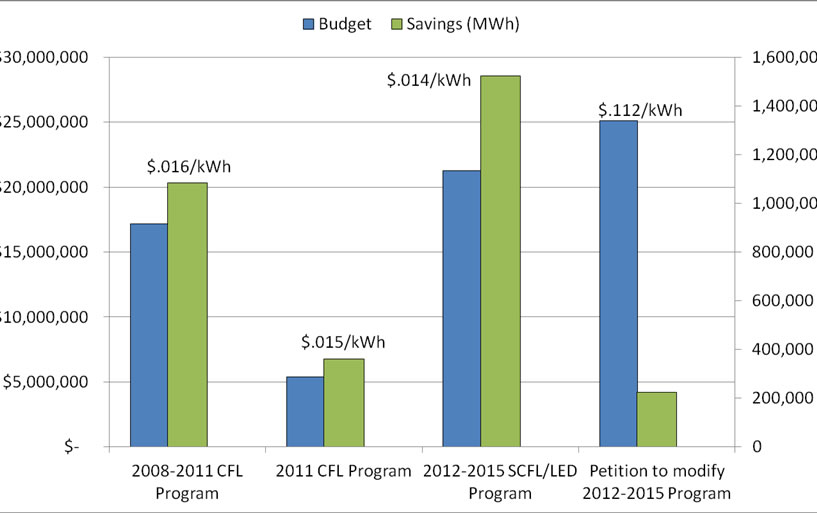By neepenergy | Tue, June 26, 12
 Residential lighting efficiency programs don’t come as cheap as they used to. Due to increasing product costs and federal Energy Information and Security Act (EISA) standards that raise minimum efficiency requirements and lower the incremental savings of high efficiency lighting products, lighting programs need bigger budgets to gain smaller but still significant energy savings. At the same time, programs are increasingly being asked to achieve long-term market transformation simultaneously with short-term aggressive resource acquisition goals.
At the June 13th NEEP Residential Lighting Workshop in Stamford, CT, Scott Kessler of NYSERDA discussed how this predicament is becoming increasingly challenging. Program administrators are tasked to measure and achieve both near-term reductions in energy use while simultaneously causing an increase in the adoption of high-efficiency products (market transformation). Measuring a single measure’s cost-effectiveness on its own, or “in a vacuum”, is fairly straight forward and scientific. However, measuring the effect of a large number of these measures as part of a market transformation that occurs over many years is an “art” that often can lead to the decision that certain products and markets no longer require incentives and are already “transformed”. Quantifying a program’s specific contribution to transforming a market is even more difficult when other programs are occurring simultaneously. Currently, NYSERDA’s point-of-sale lighting budget must only be used to support LEDs and specialty CFLs, which require significantly higher per unit incentives, thereby reducing the savings that could potentially be gained by supporting a greater variety of high efficiency lighting in the state since more cost-effective spiral CFLs are now eliminated from portfolios. More money, decreased savings.
Panelists throughout the Workshop underscored the importance of tracking market changes to reduce uncertainties involved in measuring and planning for efficiency programs. The number of lighting products available, changing costs, and the speed of technological development make tracking the market essential moving forward.
Residential lighting efficiency programs don’t come as cheap as they used to. Due to increasing product costs and federal Energy Information and Security Act (EISA) standards that raise minimum efficiency requirements and lower the incremental savings of high efficiency lighting products, lighting programs need bigger budgets to gain smaller but still significant energy savings. At the same time, programs are increasingly being asked to achieve long-term market transformation simultaneously with short-term aggressive resource acquisition goals.
At the June 13th NEEP Residential Lighting Workshop in Stamford, CT, Scott Kessler of NYSERDA discussed how this predicament is becoming increasingly challenging. Program administrators are tasked to measure and achieve both near-term reductions in energy use while simultaneously causing an increase in the adoption of high-efficiency products (market transformation). Measuring a single measure’s cost-effectiveness on its own, or “in a vacuum”, is fairly straight forward and scientific. However, measuring the effect of a large number of these measures as part of a market transformation that occurs over many years is an “art” that often can lead to the decision that certain products and markets no longer require incentives and are already “transformed”. Quantifying a program’s specific contribution to transforming a market is even more difficult when other programs are occurring simultaneously. Currently, NYSERDA’s point-of-sale lighting budget must only be used to support LEDs and specialty CFLs, which require significantly higher per unit incentives, thereby reducing the savings that could potentially be gained by supporting a greater variety of high efficiency lighting in the state since more cost-effective spiral CFLs are now eliminated from portfolios. More money, decreased savings.
Panelists throughout the Workshop underscored the importance of tracking market changes to reduce uncertainties involved in measuring and planning for efficiency programs. The number of lighting products available, changing costs, and the speed of technological development make tracking the market essential moving forward.
 NYSERDA predicts higher budgets and lower savings for residential lighting, requiring a change from past and planned program goals
NYSERDA predicts higher budgets and lower savings for residential lighting, requiring a change from past and planned program goals